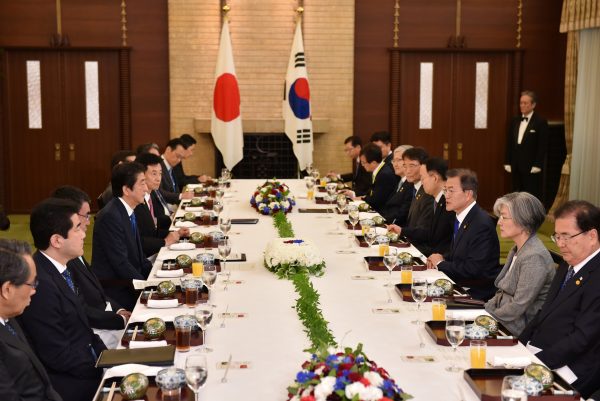To understand the prospects of a Seoul–Tokyo reset, we need to understand the diplomatic scope that leaders have to shape the relationship and the structural factors that serve to constrain their role.
There is a major institutional constraint on the leaders of both countries, particularly on the South Korean side, in managing the ever-persistent history problems in the bilateral relationship. This is the 1965 treaty to normalise relations and its attendant agreements. Yet, what is less obvious is that this treaty has become more of a constraint over time, particularly since South Korea embarked on its democratisation process in the late 1980s.
During South Korea’s authoritarian era, history problems were managed with Japan in the context of a largely state-centric process. As democratisation began, the powerful victims’ redress movements emerged. As they refined their pressure tactics on the South Korean government, diplomacy became more of a two-level game in Seoul. Through a decades-long process of trial and error, these redress movements have found that the most powerful pressure tactic at their disposal is litigation in the South Korean courts.
If we look at the trajectory of Tokyo–Seoul relations over the last 10 years, the main source of friction has been litigation wins by the victim redress movements in South Korea. These litigation outcomes, which have challenged the 1965 agreement between the two governments, have significantly narrowed the scope of options that the leaders of Japan and South Korea have in managing the relationship. The variables of leadership transition, leadership style and party affiliation have now become less consequential.
Most democratically elected South Korean leaders have come to power pledging to adopt a ‘forward looking approach’ on the bilateral relationship. The same can be said for many Japanese leaders. Former leaders, Kim Dae-jung of South Korea, and Keizo Obuchi of Japan were regarded as visionary leaders for the bilateral relationship. In recognition of the limitations of past settlements, the two leaders issued a joint declaration in 1998, spelling out a path to a more future-oriented relationship. This approach was more feasible at that time as the victim redress movements had not yet leveraged the judiciary in South Korea.
Still, once the victims began to win lawsuits in Seoul, the options that South Korean leaders had vis-a-vis Japan largely became limited to deciding to what extent litigation outcomes against Japan ought to be enforced and how to go about doing so. In turn, Japanese leaders became focussed on how to defend the 1965 treaty, how to dissuade their South Korean counterparts from enforcing litigation outcomes against them, and what form of retaliatory action to take if these outcomes were enforced.
From Tokyo’s perspective, the enforcement of victim litigation wins is connected with progressive party politics in South Korea. Yet it is unthinkable that any South Korean leader — whether affiliated with the progressive or conservative party — would dismiss or ignore a litigation win by one of the colonial victim groups in Seoul. Even if a South Korean leader decided against enforcing the ruling, they would raise the matter with Tokyo through diplomatic channels before reaching that decision. Judging from the past decade of bilateral interactions, this act would draw ire from Japanese officials and cause bilateral tensions to rise.
This pattern of friction that characterises the two countries’ contemporary relationship renders the common suggestion that Tokyo and Seoul would benefit from mediation by a third-party state infeasible. This is because their mutual history problems not only manifest bilaterally, but also in South Korea’s state–society relations and in the context of its separation of powers.
Hopes can’t be pinned on a leadership transition when speculating about whether Seoul and Tokyo relations will soon undergo a reset. In the short term, the trajectory of their relationship will most likely be determined by the presence or absence of victim redress lawsuits and their outcomes. Bilateral tension over these victim-centred issues is also increasingly emerging in the context of UNESCO. Seoul objects to Tokyo’s bid to have World Heritage status conferred on sites in Japan where Korean colonial-era labourers once toiled, particularly if that history is not acknowledged at the sites in question.
Still, this is not to suggest that leaders can have no significant role in shaping the bilateral relationship. Moon’s successor — and his Japanese counterpart Prime Minister Fumio Kishida — should aim to silo their history problems from the economic, defence and cultural realms of the bilateral relationship. This could be achieved by keeping history problems off the agenda at summit meetings and discussing them in a separate diplomatic forum instead.
The two leaders should avoid using economic, defence and cultural policies as retaliatory measures when history problems flare. This would minimise diplomatic fallout and mitigate their tendency to undermine the positive aspects of the relationship.
Lauren Richardson is a Lecturer in the Department of International Relations, The Australian National University.

